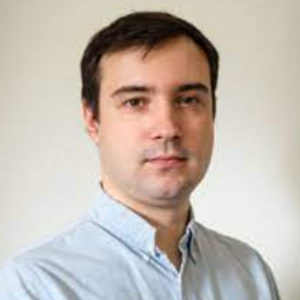Title : Thermoresponsive nanocarriers for doxorubicin delivery combined with hyperthermia
Abstract:
Due to their ability to carry anticancer drugs and generate localized heat when exposed to an alternating magnetic field, superparamagnetic iron oxide (SPIO) nanoparticles (NPs) can be used as multimodal cancer therapy agent by combining chemotherapy and hyperthermia. Fe3O4 nanoparticles were synthesized with covalent grafting of a biocompatible responsive copolymer based on 2-(2-methoxy) ethyl methacrylate (MEO2MA) and oligo (ethyleneglycol) methacrylate (OEGMA) on a ferromagnetic core. Lower critical solution temperature (LCST) of the core/shell NPs was tuned in physiological media in order to release the cancer drug at controlled temperatures. The 41-42°C LCST was obtained with a copolymer composed with 60% MEO2MA and 40% OEGMA. The second step consisted to functionalize the same core/shell by grafting folic acid (FA), a biological cancer targeting molecule at the end of the MEO2MA60-co-OEGMA40 copolymer. Both types of NPs (NP and NP-FA) were loaded with the anticancer agent doxorubicin (DOX). In vitro, DOX release kinetics was investigated at 42°c: 25% at 5h, 50% at 24h and 100% at 56h of DOX release were measured for both types of NP. At 37°C, NPs were found stable until 24h (<10% DOX release).
Further, the viability of human ovarian cancer cells (Skov3) exposed to NPs, free DOX or DOX-NPs for 24h at 41°C or 37°C for control cells, was assessed by measuring cell metabolic activity (MTT test). Results showed that NPs (without DOX) preserved cell viability (> 78.44 ± 9.48 %) irrespective of the temperature and the NP concentration. DOX-NPs at 41°C strongly decrease cell viability (32.97 ± 4.31 % cell viability vs 66.03 ± 5.15 % at 37°C). Compared with free DOX, DOX-NPs at 37°C were significantly less cytotoxic (66.03 ± 5.15 % vs 32.97 ± 4.31 % cell viability for 20 µg/ml DOX). At 41°C, cell viabilities were 32.97 ± 4.31 % and 17.25 ± 1.80 % cell for respectively DOX-NPs and free DOX. Considering that the release of DOX from NPS during 24h at 41°C was only 50%, DOX-NP cytotoxicity (32.97 ± 4.31 %) was found comparable to that (25.84 ± 6.82 %) obtained for 10 µg/ml free DOX.
The last step of the study concerned FA functionalized DOX-NPs (DOX-NP-FA). Skov3 cells highly express FA receptors on the external surface of their plasmatic membrane and need to be maintained in FA-free medium to favor the binding of NPs to the receptors. Because the lack of FA at 41°C during 24h is detrimental for cell viability, experiments were carried out at 37°C and at 41°C for 5h. Preliminary results showed that DOX-NP-FA were slightly less cytotoxic than free DOX at 37°C (59.47±6.63% vs 47.33±6.63% cell viability). At 41°C, the loss of cell viability was found equivalent for both agents.
This study demonstrates the potential of Fe3O4@P(MEO2MA60-co-OEGMA40) nanoparticles for cancer treatment combining chemotherapy and hyperthermia.
Acknowledgements: This work was supported by the JCS «Center for International Programs», Kazakhstan.
Audience take away:
• This presentation establishes the potential of supermagnetic iron oxide nanoparticles in the treatment of ovarian cancers combining chemotherapy and hyperthermia.
• This work opens the way to the development of core/shell nanomaterials for drug delivery.



